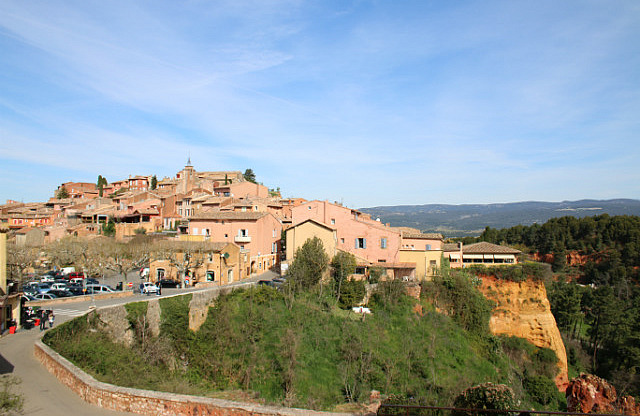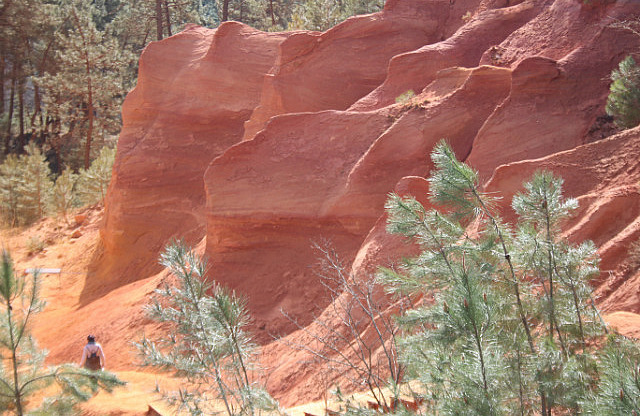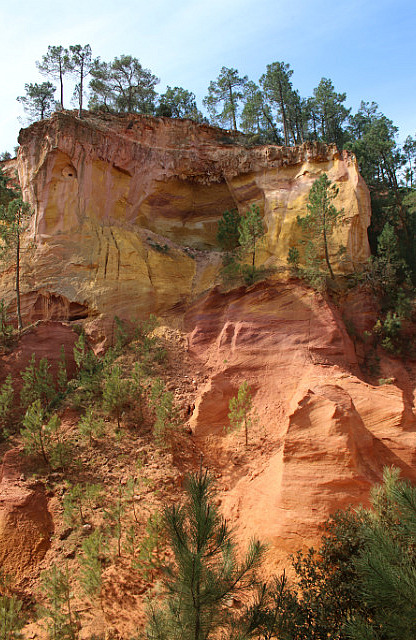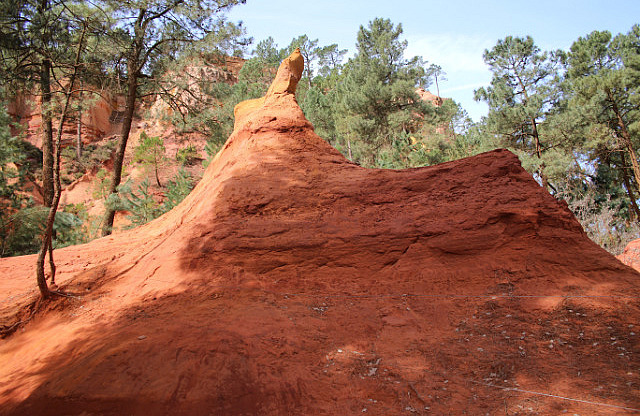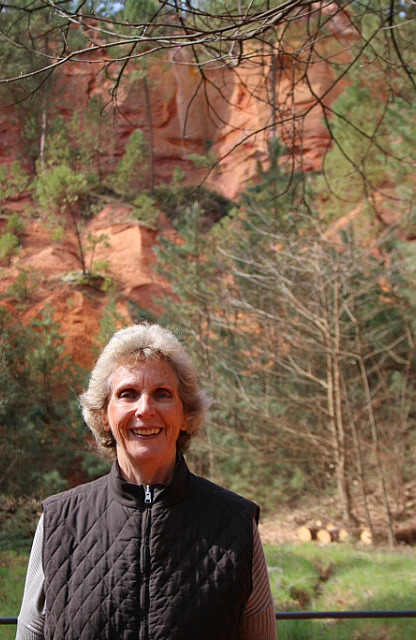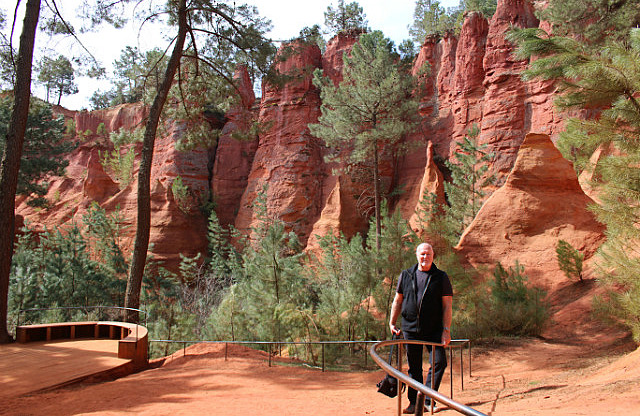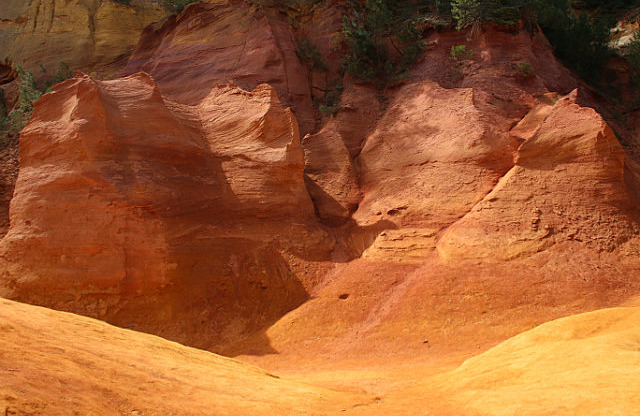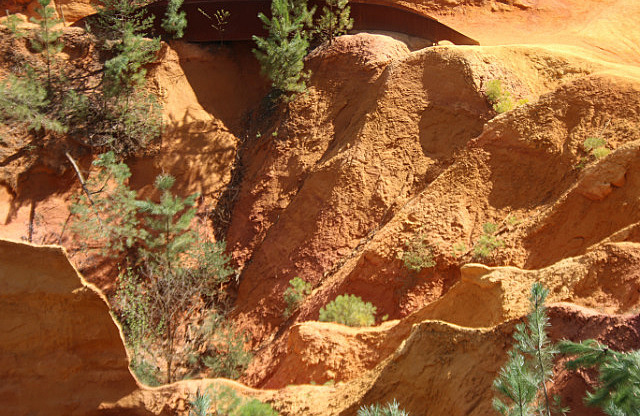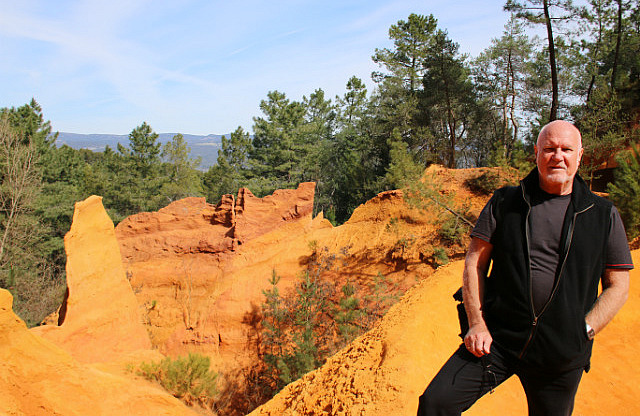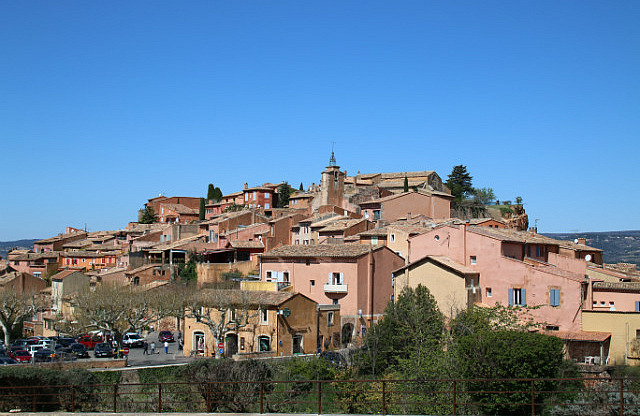Galgano
100+ Posts
Orange on Market Day
Apr 9, 2015
Tom was going to be on a very short leash today. He still managed to provide misinformation that for the second day in a row set us off on the wrong road at the same roundabout. Despite this, it was a quiet and un-eventful drive across country and up the motorway to Orange.
It was market day and yet we had no difficulty parking on the fringe of the old town centre, just a 500 metre walk into the centre of town where the markets were set up. We had the feeling that while this is a large market, it is more for locals than tourists. Apart from buying a new wallet, we weren't there for the market.
Apart from an urgent need to find a WC, we were also in search of the TIO. Neither was signposted or easy to find. In desperation, we fell back on the usual option of going into a café where I would have a coffee and we could use their toilet. Orange is uniquely Orange. We ordered our drinks and took a table. Then enquired about where their toilet was, only to be told, "we don’t have one". Ches is pretty sure they did, but it was behind a secret door. Gulp down coffee and head on up the street. Find WC but it won’t accept our coins and refuses to open. Mine does after five attempts, Ches’s never does. Back to main street where Pizzaria has one and no problems in letting Ches use it.
All is now right with the world, or will be if we can ever locate the TIO. We do, right beside the main site we have come to see in Orange. The Roman Theatre.
This is one of only three left in the world with its stage wall still in place and it is vast. I wasn’t prepared to make the same mistake as I did yesterday, and accepted that while the stage wall is as it was after 2,000 years, the seating, with the exception of the first few rows has been rebuilt. Having come to see the stage, I suggested that while not on the same scale as the Pont du Gard it is almost as impressive, particularly when you visualise what it would have looked like all faced with decorated and carved marble and statues in all the niches.
We took the audio tour and sat for an hour on the front seats, soaking up the sun and listening to the story of the theatre and Orange (Oh-rahnge). Originally a celtic town, Caesars 2nd legion were rewarded in retirement with land in the area as they had been responsible for subjugating it. Roman soldiers weren’t necessarily “Italian”, however in the case of Caesars legions, they were primarily the unemployed of Rome and probably only 3,500 men. His legions owed their allegiance to him rather than Rome, so I speculated that having murdered him, the senate or whoever, were happy to honour the retirement contract and settle them with land as far away from Rome as possible. A theatre with all day performance on one hundred days of the year was also designed to keep them amused rather than engaged in politics.
Originally tragedies were the main feature, with comedy and improvisation to follow. This allowed them lift their spirits after the gravity of the tragedy. I remember an episode of “Time Team” when they demonstrated the acting of a tragedy. The lines were delivered with extreme “melodramatic” diction. By contrast, the comedies and improvisation was pretty vulgar and eventually evolved into the pornographic and became the most popular. Guy’s in tunics with long swing “*****” .
When Christianity became the state religion around 300 AD, the theatre was closed down and was allowed to deteriorate. From then on, it became a quarry with the stone seating removed to build houses and the marble to decorate the homes of the wealthy. By the time the barbarians from the north (read Germans) sacked the town, people were building houses inside the theatre, using the wall as a wall of their houses, for protection.
By the late 1500’s a soldier from the Netherlands were given the town by Charlemagne and he took on the title of William, Prince of Orange. Spain ruled the Netherlands at this stage and it wasn’t till they won their independence that he could return to the Netherlands and establish the House of Orange.
For those who can stand a little more history, a Dutch lecturer I had years ago (Economic History), explained that in Dutch history, they were taught that the Spanish Armada was a Spanish fleet of troops sailing to put down a rebellion in the Netherlands and that Drake took advantage of the fact that the ships were overloaded with troops and represented an easy target.
The Spanish Armada (Spanish: Grande y Felicísima Armada , literally "Great and Most Fortunate Navy") was a Spanish fleet of 130 ships that sailed from A Coruña in August 1588, under the command of the Duke of Medina Sidonia with the purpose of escorting an army from Flanders to invade England. The strategic aim was to overthrow Queen Elizabeth I of England and the Tudor establishment of Protestantism in England, with the expectation that this would put a stop to English interference in the Spanish Netherlands and to the harm caused to Spanish interests by English and Dutch privateering.
Whatever, the Netherland regained their independence from Spain, the Nassau family became the House of Orange, their George eventually assumed the throne of England and as a Protestant lead the protestants in the Wars of Religion in the south of France, supported the establishment of The Orange Free State in South Africa, the “Orange” Northern Ireland and various protestant “orange” communities in the U.S.
Louis X1V, the “Sun King” captured Orange in 1672 and declared the Theatre wall as the greatest wall in his kingdom.
Ironically, Orange attracted international attention in the 1990s, when it elected a member of Front National as its mayor. It is now run by Jacques Bompard, a member of the conservative Movement for France which he joined after having resigned from the Front National. Ironic, because we haven’t been in a town and seen as many Hijab wearing women as we did in Orange.
We visited the museum opposite the theatre. I’s a fantastic compact museum that rather than have extensive impersonal exhibits, has themes in each room, largely around families and several local artists. One room is just a furnished living room with all the furniture from one of the ruling families, another is full of murals depicting the introduction of fabric printing.
No more than 300 metres from the Roman Theatre is the late 1800’s theatre. Kind of a contrast. Massive 6,000 seater for everyone and probably a 400 seater for the glitterati in the 2nd half of the 1800's. Didn't time change. And now its the 6,00 seater that's in use again with regular concerts and operas.
By 1.30 we were ready for lunch so we took up a bench seat in the park with all the locals and enjoyed the sun while eating filled baguettes we had brought from home. We followed this up with a long walk through town to see the Triumphal Arch. This one is a ripper. A large central arch with smaller arch on each side. Some interesting panels have survived. Several depict shields scattered on the ground with the odd sword and scavenging dogs. Here Ches and I had a different take on them. She thought several looked like pigs. I suggested that when they looked at the finished product, the designer said, "why are there pigs?" and the stonemason said," I just carved what you had drawn. It's not my fault if you draw dogs that look like pigs."
Another depicts the wreckage of a ship with broken mast, rope and block and tackle and a trident the most visible.
We were both about worn out and dying of thirst. All the way back we passed closed shops. Eventually, close to the carpark, we decided to try the drive through fast food place. We had no idea what it was. Twas McDonalds. We had observed that signs on roads are only around a half metre square and are green arches. This place had no signage other than the green arch sign at the driveway. Beggars cant be choosers and we were thirsty. We had mango frappe (basically a small mango thick shake) and it came with the universal "brain freeze"
A number of the older residents seem to use it as a meeting place to pass the time. Airconditioned and clean.
Tom gave us an uneventful trip back to Bonnieux.
History Roman Orange was founded in 35 BC by veterans of the Second legion as Arausio (after the local Celtic water god), or Colonia Julia Firma Secundanorum Arausio in full, "the Julian colony of Arausio established by the soldiers of the second legion." The name was originally unrelated to that of the orange fruit, but was later conflated with it.
A previous Celtic settlement with that name existed in the same place and a major battle, which is generally known as the Battle of Arausio, had been fought in 105 BC between two Roman armies and the Cimbri and Teutones tribes.
Arausio covered an area of some 170 acres (69 ha) and was well endowed with civic monuments – as well as the theatre and arch, it had a monumental temple complex and a forum.
It was the capital of a wide area of northern Provence, which was parcelled up into lots for the Roman colonists. "Orange of two thousand years ago was a miniature Rome, complete with many of the public buildings that would have been familiar to a citizen of the Roman Empire, except that the scale of the buildings had been reduced – a smaller theater to accommodate a smaller population, for example."
The town prospered, but was sacked by the Visigoths in 412. It had by then become largely Christianized, and from the end of the 3rd century constituted the Ancient Diocese of Orange. No longer a residential bishopric, Arausio, as it is called in Latin, is today listed by the Catholic Church as a titular see. It hosted two important synods, in 441 and 529. The Second Council of Orange was of importance in condemning what later came to be called Semipelagianism.
The sovereign Carolingian counts of Orange had their origin in the eighth century, and passed into the family of the lords of Baux. The Baux counts of Orange became fully independent with the breakup of the Kingdom of Arles after 1033. From the twelfth century, Orange was raised to a minor principality, the Principality of Orange, as a fief of the Holy Roman Empire. During this period the town and the principality of Orange belonged to the administration and province of Dauphiné.
When William the Silent, count of Nassau, with estates in the Netherlands, inherited the title Prince of Orange in 1544, the Principality was incorporated into the holdings of what became the House of Orange-Nassau. This pitched it into the Protestantside in the Wars of Religion, during which the town was badly damaged. In 1568 the Eighty Years' War began with William as stadtholder leading the bid for independence from Spain. William the Silent was assassinated in Delft in 1584. It was his son,Maurice of Nassau (Prince of Orange after his elder brother died in 1618), with the help of Johan van Oldenbarnevelt, who solidified the independence of the Dutch republic. The United Provinces survived to become the Netherlands, which is still ruled by the House of Orange-Nassau. William, Prince of Orange, ruled England as William III of England. Orange gave its name to other Dutch-influenced parts of the world, such as the Oranges (West Orange, South Orange, East Orange, Orange) in New Jersey, USA, and the Orange Free State in South Africa.
The city remained part of scattered Nassau holdings until it was captured by the forces of Louis XIV in 1672 during the Franco-Dutch War, again captured in August 1682 and was finally ceded to France in 1713 under the Treaty of Utrecht that ended the wars of Louis XIV. Following the French Revolution of 1789, Orange was absorbed into the French département of Drôme, then Bouches-du-Rhône, then finally Vaucluse. However, the title remained with the Dutch Princes of Orange.
Orange attracted international attention in the 1990s, when it elected a member of Front National as its mayor. It is now run by Jacques Bompard, a member of the conservativeMovement for France which he joined after having resigned from the Front National.
Orange was also home to the French Foreign Legion's armored 1er REC or First Foreign Cavalry Regiment. The 1er REC officially moved to Carpiagne on July 10th 2014.
Main sights[edit] The town is renowned for its Roman architecture and its Roman theatre, the Théâtre antique d'Orange, is described as the most impressive still existing in Europe. The fine Triumphal Arch of Orange is often said to date from the time of Augustus or Tiberius, but is probably much later, perhaps Severan.[3] The arch, theatre and surroundings were listed in 1981 by UNESCO as a World Heritage Site.
The Musée (Museum) displays the biggest (7.56 x 5.90 m) cadastral Roman maps ever recovered, etched on marble. They cover the area between Orange, Nîmes and Montélimar
The Théâtre antique d'Orange ("Ancient Theatre of Orange") is an ancient Roman theatre, in Orange, southern France, built early in the 1st century AD. It is owned by the municipality of Orange and is the home of the summer opera festival, the Chorégies d'Orange.
It is one of the best preserved of all the Roman theatres in the Roman colony of Arausio (or, more specifically, Colonia Julia Firma Secundanorum Arausio:
"the Julian colony of Arausio established by the soldiers of the second
legion") which was founded in 40 BC. Playing a major role in the life
of the citizens, who spent a large part of their free time there, the
theatre was seen by the Roman authorities not only as a means of
spreading Roman culture to the colonies, but also as a way of
distracting them from all political activities.
Mime, pantomime, poetry readings and the "attelana" (a kind of farce rather like the commedia dell'arte)
was the dominant form of entertainment, much of which lasted all day.
For the common people, who were fond of spectacular effects, magnificent
stage sets became very important, as was the use of stage machinery.
The entertainment offered was open to all and free of charge.
As the Western Roman Empire declined during the 4th century, by which time Christianity
had become the official religion, the theatre was closed by official
edict in AD 391 since the Church opposed what it regarded as uncivilized
spectacles. After that, the theatre was abandoned completely. It was
sacked and pillaged by the "barbarians" and was used as a defensive post in the Middle Ages. During the 16th-century religious wars, it became a refuge for the townspeople.
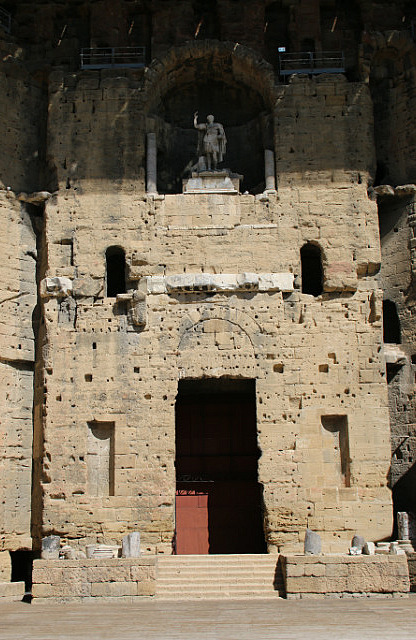
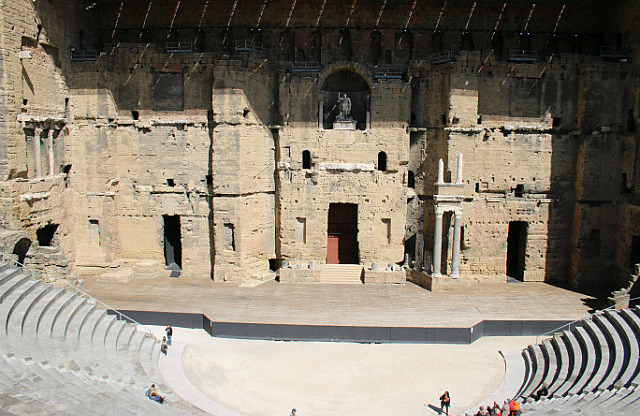
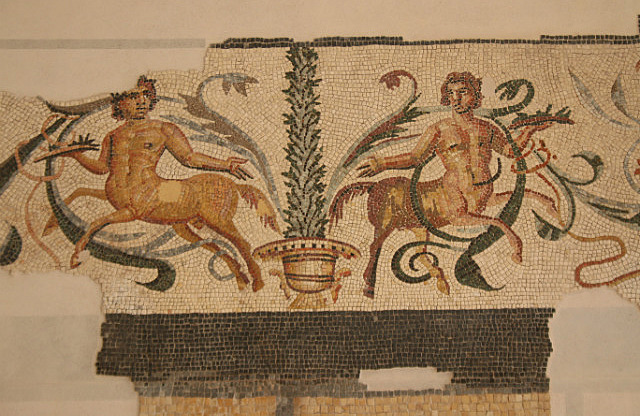
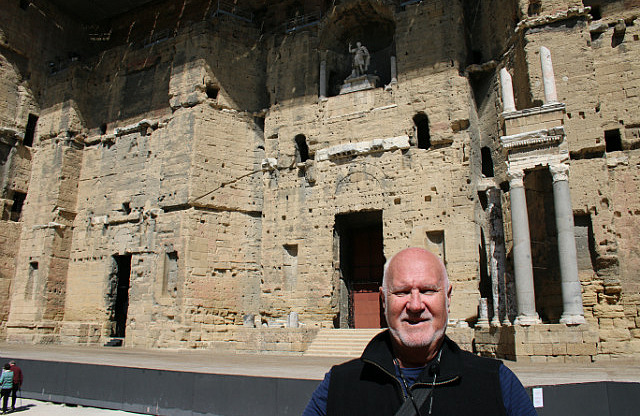
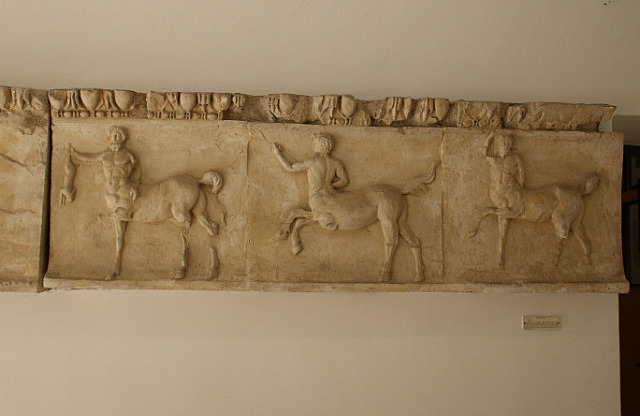
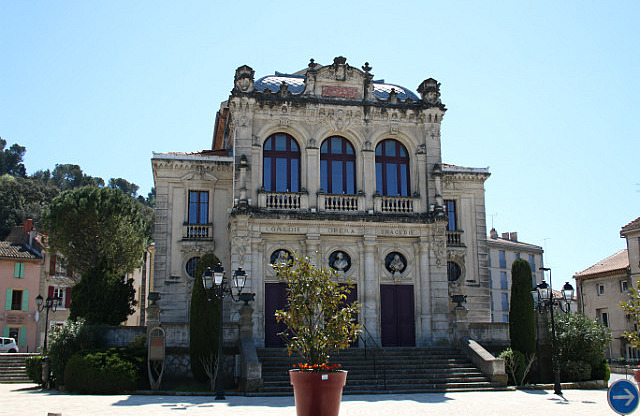
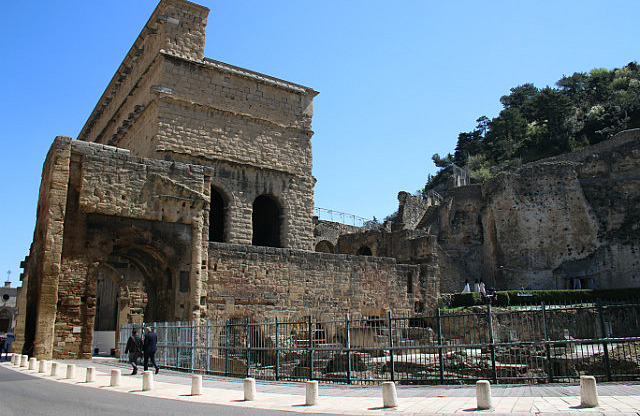
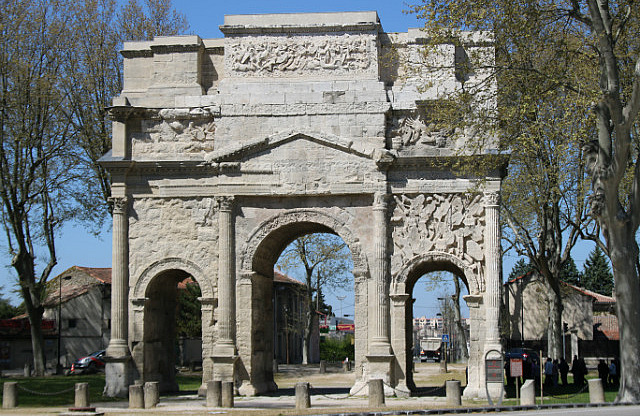
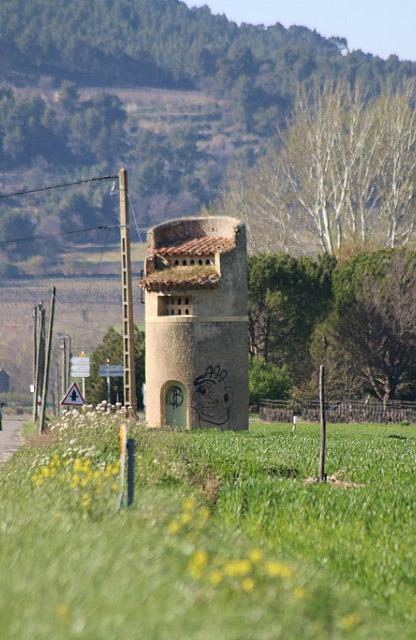
Apr 9, 2015
Tom was going to be on a very short leash today. He still managed to provide misinformation that for the second day in a row set us off on the wrong road at the same roundabout. Despite this, it was a quiet and un-eventful drive across country and up the motorway to Orange.
It was market day and yet we had no difficulty parking on the fringe of the old town centre, just a 500 metre walk into the centre of town where the markets were set up. We had the feeling that while this is a large market, it is more for locals than tourists. Apart from buying a new wallet, we weren't there for the market.
Apart from an urgent need to find a WC, we were also in search of the TIO. Neither was signposted or easy to find. In desperation, we fell back on the usual option of going into a café where I would have a coffee and we could use their toilet. Orange is uniquely Orange. We ordered our drinks and took a table. Then enquired about where their toilet was, only to be told, "we don’t have one". Ches is pretty sure they did, but it was behind a secret door. Gulp down coffee and head on up the street. Find WC but it won’t accept our coins and refuses to open. Mine does after five attempts, Ches’s never does. Back to main street where Pizzaria has one and no problems in letting Ches use it.
All is now right with the world, or will be if we can ever locate the TIO. We do, right beside the main site we have come to see in Orange. The Roman Theatre.
This is one of only three left in the world with its stage wall still in place and it is vast. I wasn’t prepared to make the same mistake as I did yesterday, and accepted that while the stage wall is as it was after 2,000 years, the seating, with the exception of the first few rows has been rebuilt. Having come to see the stage, I suggested that while not on the same scale as the Pont du Gard it is almost as impressive, particularly when you visualise what it would have looked like all faced with decorated and carved marble and statues in all the niches.
We took the audio tour and sat for an hour on the front seats, soaking up the sun and listening to the story of the theatre and Orange (Oh-rahnge). Originally a celtic town, Caesars 2nd legion were rewarded in retirement with land in the area as they had been responsible for subjugating it. Roman soldiers weren’t necessarily “Italian”, however in the case of Caesars legions, they were primarily the unemployed of Rome and probably only 3,500 men. His legions owed their allegiance to him rather than Rome, so I speculated that having murdered him, the senate or whoever, were happy to honour the retirement contract and settle them with land as far away from Rome as possible. A theatre with all day performance on one hundred days of the year was also designed to keep them amused rather than engaged in politics.
Originally tragedies were the main feature, with comedy and improvisation to follow. This allowed them lift their spirits after the gravity of the tragedy. I remember an episode of “Time Team” when they demonstrated the acting of a tragedy. The lines were delivered with extreme “melodramatic” diction. By contrast, the comedies and improvisation was pretty vulgar and eventually evolved into the pornographic and became the most popular. Guy’s in tunics with long swing “*****” .
When Christianity became the state religion around 300 AD, the theatre was closed down and was allowed to deteriorate. From then on, it became a quarry with the stone seating removed to build houses and the marble to decorate the homes of the wealthy. By the time the barbarians from the north (read Germans) sacked the town, people were building houses inside the theatre, using the wall as a wall of their houses, for protection.
By the late 1500’s a soldier from the Netherlands were given the town by Charlemagne and he took on the title of William, Prince of Orange. Spain ruled the Netherlands at this stage and it wasn’t till they won their independence that he could return to the Netherlands and establish the House of Orange.
For those who can stand a little more history, a Dutch lecturer I had years ago (Economic History), explained that in Dutch history, they were taught that the Spanish Armada was a Spanish fleet of troops sailing to put down a rebellion in the Netherlands and that Drake took advantage of the fact that the ships were overloaded with troops and represented an easy target.
The Spanish Armada (Spanish: Grande y Felicísima Armada , literally "Great and Most Fortunate Navy") was a Spanish fleet of 130 ships that sailed from A Coruña in August 1588, under the command of the Duke of Medina Sidonia with the purpose of escorting an army from Flanders to invade England. The strategic aim was to overthrow Queen Elizabeth I of England and the Tudor establishment of Protestantism in England, with the expectation that this would put a stop to English interference in the Spanish Netherlands and to the harm caused to Spanish interests by English and Dutch privateering.
Whatever, the Netherland regained their independence from Spain, the Nassau family became the House of Orange, their George eventually assumed the throne of England and as a Protestant lead the protestants in the Wars of Religion in the south of France, supported the establishment of The Orange Free State in South Africa, the “Orange” Northern Ireland and various protestant “orange” communities in the U.S.
Louis X1V, the “Sun King” captured Orange in 1672 and declared the Theatre wall as the greatest wall in his kingdom.
Ironically, Orange attracted international attention in the 1990s, when it elected a member of Front National as its mayor. It is now run by Jacques Bompard, a member of the conservative Movement for France which he joined after having resigned from the Front National. Ironic, because we haven’t been in a town and seen as many Hijab wearing women as we did in Orange.
We visited the museum opposite the theatre. I’s a fantastic compact museum that rather than have extensive impersonal exhibits, has themes in each room, largely around families and several local artists. One room is just a furnished living room with all the furniture from one of the ruling families, another is full of murals depicting the introduction of fabric printing.
No more than 300 metres from the Roman Theatre is the late 1800’s theatre. Kind of a contrast. Massive 6,000 seater for everyone and probably a 400 seater for the glitterati in the 2nd half of the 1800's. Didn't time change. And now its the 6,00 seater that's in use again with regular concerts and operas.
By 1.30 we were ready for lunch so we took up a bench seat in the park with all the locals and enjoyed the sun while eating filled baguettes we had brought from home. We followed this up with a long walk through town to see the Triumphal Arch. This one is a ripper. A large central arch with smaller arch on each side. Some interesting panels have survived. Several depict shields scattered on the ground with the odd sword and scavenging dogs. Here Ches and I had a different take on them. She thought several looked like pigs. I suggested that when they looked at the finished product, the designer said, "why are there pigs?" and the stonemason said," I just carved what you had drawn. It's not my fault if you draw dogs that look like pigs."
Another depicts the wreckage of a ship with broken mast, rope and block and tackle and a trident the most visible.
We were both about worn out and dying of thirst. All the way back we passed closed shops. Eventually, close to the carpark, we decided to try the drive through fast food place. We had no idea what it was. Twas McDonalds. We had observed that signs on roads are only around a half metre square and are green arches. This place had no signage other than the green arch sign at the driveway. Beggars cant be choosers and we were thirsty. We had mango frappe (basically a small mango thick shake) and it came with the universal "brain freeze"
A number of the older residents seem to use it as a meeting place to pass the time. Airconditioned and clean.
Tom gave us an uneventful trip back to Bonnieux.
History Roman Orange was founded in 35 BC by veterans of the Second legion as Arausio (after the local Celtic water god), or Colonia Julia Firma Secundanorum Arausio in full, "the Julian colony of Arausio established by the soldiers of the second legion." The name was originally unrelated to that of the orange fruit, but was later conflated with it.
A previous Celtic settlement with that name existed in the same place and a major battle, which is generally known as the Battle of Arausio, had been fought in 105 BC between two Roman armies and the Cimbri and Teutones tribes.
Arausio covered an area of some 170 acres (69 ha) and was well endowed with civic monuments – as well as the theatre and arch, it had a monumental temple complex and a forum.
It was the capital of a wide area of northern Provence, which was parcelled up into lots for the Roman colonists. "Orange of two thousand years ago was a miniature Rome, complete with many of the public buildings that would have been familiar to a citizen of the Roman Empire, except that the scale of the buildings had been reduced – a smaller theater to accommodate a smaller population, for example."
The town prospered, but was sacked by the Visigoths in 412. It had by then become largely Christianized, and from the end of the 3rd century constituted the Ancient Diocese of Orange. No longer a residential bishopric, Arausio, as it is called in Latin, is today listed by the Catholic Church as a titular see. It hosted two important synods, in 441 and 529. The Second Council of Orange was of importance in condemning what later came to be called Semipelagianism.
The sovereign Carolingian counts of Orange had their origin in the eighth century, and passed into the family of the lords of Baux. The Baux counts of Orange became fully independent with the breakup of the Kingdom of Arles after 1033. From the twelfth century, Orange was raised to a minor principality, the Principality of Orange, as a fief of the Holy Roman Empire. During this period the town and the principality of Orange belonged to the administration and province of Dauphiné.
When William the Silent, count of Nassau, with estates in the Netherlands, inherited the title Prince of Orange in 1544, the Principality was incorporated into the holdings of what became the House of Orange-Nassau. This pitched it into the Protestantside in the Wars of Religion, during which the town was badly damaged. In 1568 the Eighty Years' War began with William as stadtholder leading the bid for independence from Spain. William the Silent was assassinated in Delft in 1584. It was his son,Maurice of Nassau (Prince of Orange after his elder brother died in 1618), with the help of Johan van Oldenbarnevelt, who solidified the independence of the Dutch republic. The United Provinces survived to become the Netherlands, which is still ruled by the House of Orange-Nassau. William, Prince of Orange, ruled England as William III of England. Orange gave its name to other Dutch-influenced parts of the world, such as the Oranges (West Orange, South Orange, East Orange, Orange) in New Jersey, USA, and the Orange Free State in South Africa.
The city remained part of scattered Nassau holdings until it was captured by the forces of Louis XIV in 1672 during the Franco-Dutch War, again captured in August 1682 and was finally ceded to France in 1713 under the Treaty of Utrecht that ended the wars of Louis XIV. Following the French Revolution of 1789, Orange was absorbed into the French département of Drôme, then Bouches-du-Rhône, then finally Vaucluse. However, the title remained with the Dutch Princes of Orange.
Orange attracted international attention in the 1990s, when it elected a member of Front National as its mayor. It is now run by Jacques Bompard, a member of the conservativeMovement for France which he joined after having resigned from the Front National.
Orange was also home to the French Foreign Legion's armored 1er REC or First Foreign Cavalry Regiment. The 1er REC officially moved to Carpiagne on July 10th 2014.
Main sights[edit] The town is renowned for its Roman architecture and its Roman theatre, the Théâtre antique d'Orange, is described as the most impressive still existing in Europe. The fine Triumphal Arch of Orange is often said to date from the time of Augustus or Tiberius, but is probably much later, perhaps Severan.[3] The arch, theatre and surroundings were listed in 1981 by UNESCO as a World Heritage Site.
The Musée (Museum) displays the biggest (7.56 x 5.90 m) cadastral Roman maps ever recovered, etched on marble. They cover the area between Orange, Nîmes and Montélimar
The Théâtre antique d'Orange ("Ancient Theatre of Orange") is an ancient Roman theatre, in Orange, southern France, built early in the 1st century AD. It is owned by the municipality of Orange and is the home of the summer opera festival, the Chorégies d'Orange.
It is one of the best preserved of all the Roman theatres in the Roman colony of Arausio (or, more specifically, Colonia Julia Firma Secundanorum Arausio:
"the Julian colony of Arausio established by the soldiers of the second
legion") which was founded in 40 BC. Playing a major role in the life
of the citizens, who spent a large part of their free time there, the
theatre was seen by the Roman authorities not only as a means of
spreading Roman culture to the colonies, but also as a way of
distracting them from all political activities.
Mime, pantomime, poetry readings and the "attelana" (a kind of farce rather like the commedia dell'arte)
was the dominant form of entertainment, much of which lasted all day.
For the common people, who were fond of spectacular effects, magnificent
stage sets became very important, as was the use of stage machinery.
The entertainment offered was open to all and free of charge.
As the Western Roman Empire declined during the 4th century, by which time Christianity
had become the official religion, the theatre was closed by official
edict in AD 391 since the Church opposed what it regarded as uncivilized
spectacles. After that, the theatre was abandoned completely. It was
sacked and pillaged by the "barbarians" and was used as a defensive post in the Middle Ages. During the 16th-century religious wars, it became a refuge for the townspeople.












